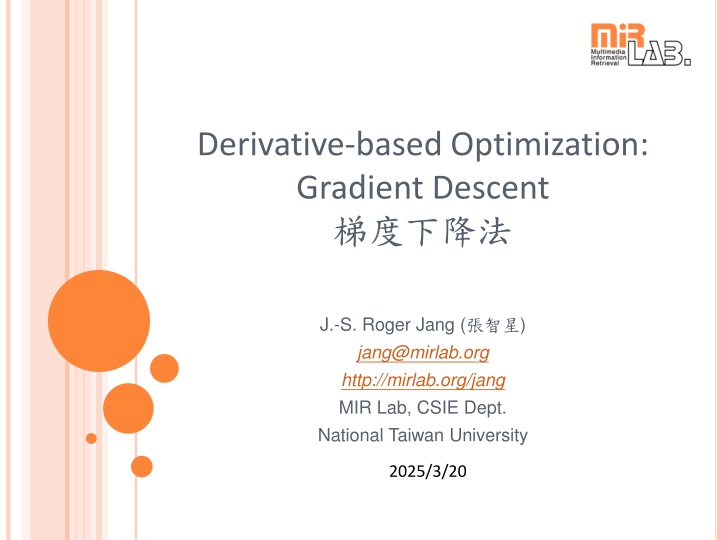
Optimize Derivative-Based Functions Using Gradient Descent
Explore the concept of derivative-based optimization through Gradient Descent, a technique to minimize functions based on gradients. Learn about directional derivatives, computing gradients, and the formula for Gradient Descent with examples and animations.
Uploaded on | 2 Views
Download Presentation

Please find below an Image/Link to download the presentation.
The content on the website is provided AS IS for your information and personal use only. It may not be sold, licensed, or shared on other websites without obtaining consent from the author. If you encounter any issues during the download, it is possible that the publisher has removed the file from their server.
You are allowed to download the files provided on this website for personal or commercial use, subject to the condition that they are used lawfully. All files are the property of their respective owners.
The content on the website is provided AS IS for your information and personal use only. It may not be sold, licensed, or shared on other websites without obtaining consent from the author.
E N D
Presentation Transcript
Derivative-based Optimization: Gradient Descent J.-S. Roger Jang ( ) jang@mirlab.org http://mirlab.org/jang MIR Lab, CSIE Dept. National Taiwan University 2025/3/20
Gradient Gradient of a multivariate function: ? ?? ? ??1 ,?? ? ??2 , ,?? ? ? ? ? = , with ? = ?1,?2, ,?? ??? Example ? ?,? =?2+?2 Animation Gradients and partial derivatives Gradients and partial derivatives Directional derivatives and the gradient Directional derivatives and the gradient Quiz inside! 2/18
Directional Derivatives Concept Gradient: Derivative along coordinate axis How to compute gradient along any direction Directional derivative Directional derivative Directional derivative of ? ?,? along ? = [?,?] with ? =1 ?? ?,? ?? ,?? ?,? ?? ?? ?,? = [? ?] = ? ?,? ? Quiz! For a give function ? ?,? , ?? ?,? achieves its maximum How to derive directional derivatives when ? = ? ?,? . How to derive directional derivatives Clear explanation! 3/18
Gradient Descent (GD) Gradient descent (GD): AKA steepest descent (SD) Goal: Minimize a function iteratively based on gradient Quiz! Formula for GD: or Vanilla GD ?????= ???? ? ? ???? ? = ? ? ? Normalized version Step size or learning rate ? ? ? ? ? = ? With momentum ? = ? ? ? + ?( ?)???? 5/18
Example of Single-Input Functions If n=1, GD reduces to the problem of going left or right. Example ( ) ( ) f = 2 f x x = 2 x x ( )now x 2 = = 2 1 x x x next now now Animation: http://www.onmyphd.com/?p=gradient.descent 6/18
Basin of Attraction in 1D Each point/region with zero gradient has a basin of attraction 7/18
Example of Two-input Functions ? = ? ?,? =?2+?2 8/18
Peaks Functions (1/2) If n=2, GD needs to find a direction in 2D plane. Example: Peaks function in MATLAB ( 1 3 , x y x f = 1 x ) ( ) ( ) ( ) 2 2 2 2 2 2 2 + + 1 3 5 1 x y x y x y 10 e x y e e 5 3 Animation: gradientDescentDemo.m Gradients is perpendicular to contours, why? 3 local maxima 3 local minima 9/18
Peaks Functions (2/2) Gradient of the peaks function dz/dx = -6*(1-x)*exp(-x^2-(y+1)^2) - 6*(1-x)^2*x*exp(-x^2- (y+1)^2) - 10*(1/5-3*x^2)*exp(-x^2-y^2) + 20*(1/5*x-x^3- y^5)*x*exp(-x^2-y^2) - 1/3*(-2*x-2)*exp(-(x+1)^2-y^2) dz/dy = 3*(1-x)^2*(-2*y-2)*exp(-x^2-(y+1)^2) + 50*y^4*exp(-x^2-y^2) + 20*(1/5*x-x^3-y^5)*y*exp(-x^2-y^2) + 2/3*y*exp(-(x+1)^2-y^2) d(dz/dx)/dx = 36*x*exp(-x^2-(y+1)^2) - 18*x^2*exp(-x^2- (y+1)^2) - 24*x^3*exp(-x^2-(y+1)^2) + 12*x^4*exp(-x^2- (y+1)^2) + 72*x*exp(-x^2-y^2) - 148*x^3*exp(-x^2-y^2) - 20*y^5*exp(-x^2-y^2) + 40*x^5*exp(-x^2-y^2) + 40*x^2*exp(-x^2-y^2)*y^5 -2/3*exp(-(x+1)^2-y^2) - 4/3*exp(-(x+1)^2-y^2)*x^2 -8/3*exp(-(x+1)^2-y^2)*x 10/18
Basin of Attraction in 2D Each point/region with zero gradient has a basin of attraction 11/18
Rosenbrock Function Rosenbrock function ( 1 , y x f = ( ) ) ( ) 2 2 + 2 100 x y x More about this function Animation: http://www.onmyphd.com/?p=gradient.descent Document on how to optimize this function 12/18 Justification for using momentum terms
Properties of Gradient Descent Properties Quiz! No guarantee for reaching global optimum Feasible for differentiable objective functions (which can have finite number of non-differential points) Performance heavily dependent on starting point and step size Variants Use adaptive step sizes Normalize the gradient by its length Use the momentum term to reduce zig-zag paths Use line minimization at each iteration 13/18
Comparisons of Gradient-based Optimization Gradient descent (GD) Treat all parameters as nonlinear Hybrid learning of GD+LSE Distinguish between linear and nonlinear Conjugate gradient descent Try to reach the minimizing point by assume the objective function is quadratic Gauss-Newton (GN) method Linearize the objective function to treat all parameters as linear Levenberg-Marquardt (LM) method Switch smoothly between GD and GN 14/18
Gauss-Newton Method Synonyms Linearization method Extended Kalman filter method Concept: General nonlinear model: y = f(x, ) linearization at = now: y = f(x, now)+a1( 1 - 1,now)+a2( 2 - 2,now) + ... LSE solution: next = now + (ATA)-1ATB 15/18
Levenberg-Marquardt Method Formula next = now + (ATA+ I)-1ATB Effects of small Gauss-Newton method big Gradient descent How to update Greedy policy Make small Cautious policy Make big 16/18
Exercises (1/2) Can we use GD to find the minimum of f(x)=|x|? What is the gradients of the following functions? Can you express y in terms of y? y =1 ? ? 1 + ? ? 1 Quiz: The gradient of y=eax can be expressed in terms of y. Why? y = 1 + ? ? What are the basins of attraction of the following curve? f(x) global maximum inflection point local minimum global minimum x 17/18
Exercises (2/2) What is the gradient of f(x,y) = sin(x)eyat ( , 0)? Answer: (-1, 0) Compute the directional derivative of f(x,y) = sin(x)ey at the point ( , 0) in the direction of (3, 4). Answer: -0.6 18/18
